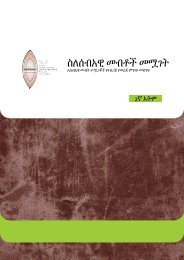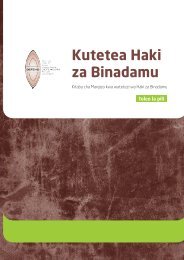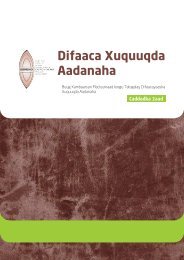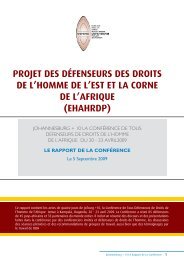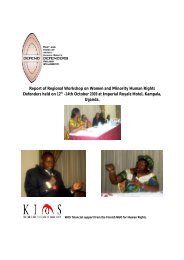English PDF - East and Horn of Africa Human Rights Defenders ...
English PDF - East and Horn of Africa Human Rights Defenders ...
English PDF - East and Horn of Africa Human Rights Defenders ...
Create successful ePaper yourself
Turn your PDF publications into a flip-book with our unique Google optimized e-Paper software.
Conference Report: Resources <strong>and</strong> Proceedings 29Currently in the Sudan, there are too few training courses for journalists. This has increased thenumber <strong>of</strong> quack practitioners who are masquerading as journalists who do not know that injournalism one must ensure that justice is seen by reporting objectively <strong>and</strong> not being biasedregardless <strong>of</strong> the story. Some <strong>of</strong> these journalists do not know the code <strong>of</strong> ethics. Anyone that canwrite <strong>and</strong> speak over the radio is called a journalist. Subjectivity comes in, whatever one thinks isright is right; people’s opinions rather than facts matter <strong>and</strong> fill airwaves <strong>and</strong> newspapers.Journalists from South Sudan formed the Association <strong>of</strong> Media Development in Southern Sudan(AMDISS), also referred to as South Sudanese Journalist Association, bringing them togetherunder one umbrella with its headquarters in Juba. However, there is a major rift between the olderjournalists <strong>and</strong> the new generation. In July 2006, a group <strong>of</strong> journalists sat down <strong>and</strong> proposed tostart another association which has not yet been given a name.The number <strong>of</strong> radio stations is increasing. Compared to one radio station (Radio Juba) before,today Juba has five stations, i.e. Capital FM, Liberty FM, Miraya FM (owned by the UN), RadioJuba <strong>and</strong> BBC. In the same way, there are three newspapers, i.e. Southern Eye, Juba Post <strong>and</strong>Sudan Mirror.Compared to other countries, Southern Sudanese media is not yet sensational. Most articles in thenewspapers <strong>and</strong> on radio programmes contain mainly hard news items.As regards fulfilling Article 19 <strong>of</strong> The Declaration <strong>of</strong> <strong>Human</strong> <strong>Rights</strong>, with the discussion above,to a greater extent freedom <strong>of</strong> speech <strong>and</strong> expression is a myth rather than a reality becausepeople are not allowed to voice their opinions like the article stipulates. However, given theincreased number <strong>of</strong> radio stations, newspapers <strong>and</strong> magazines in South Sudan, one could say thatArticle 19 is being honored to some extent.TanzaniaChristopher Kidanka (Information Officer, Legal <strong>and</strong><strong>Human</strong> <strong>Rights</strong> Centre)Tanzanian journalism has come a long way. What we have today is aresult <strong>of</strong> a long history. Once there was no modern media through whichto pass information on to a larger community. There was only thetraditional media which were contextually relevant <strong>and</strong> effective at thetime. Then came the missionaries with their modern <strong>and</strong> relativelysophisticated infrastructure to facilitate their modern <strong>and</strong> ‘important’mission; preaching the Gospel. The missionaries therefore establishednews sheets that met their communication needs.© EHAHRDPAccording to records, the first news sheet called Msimulizi (story-teller)was established in Zanzibar Isl<strong>and</strong> in 1888. Habari za Mwezi (Monthly News) followed in 1894.The main objective <strong>of</strong> these news sheets was to publicize the missionaries as well as the colonialGovernment’s ‘good’ work. Since the missionaries had paved the way for colonial establishment,their media could not have played the watchdog role as Nkwabi Ng’wanakilala puts it in hisbook, Mass Communication <strong>and</strong> Development <strong>of</strong> Socialism in Tanzania.The news sheets were adequately funded <strong>and</strong> were sold at 5 to 10 cents. (Today a newspaper inTanzania costs between 150/- shillings <strong>and</strong> 400/- shillings. One shilling equals 100 cents).



